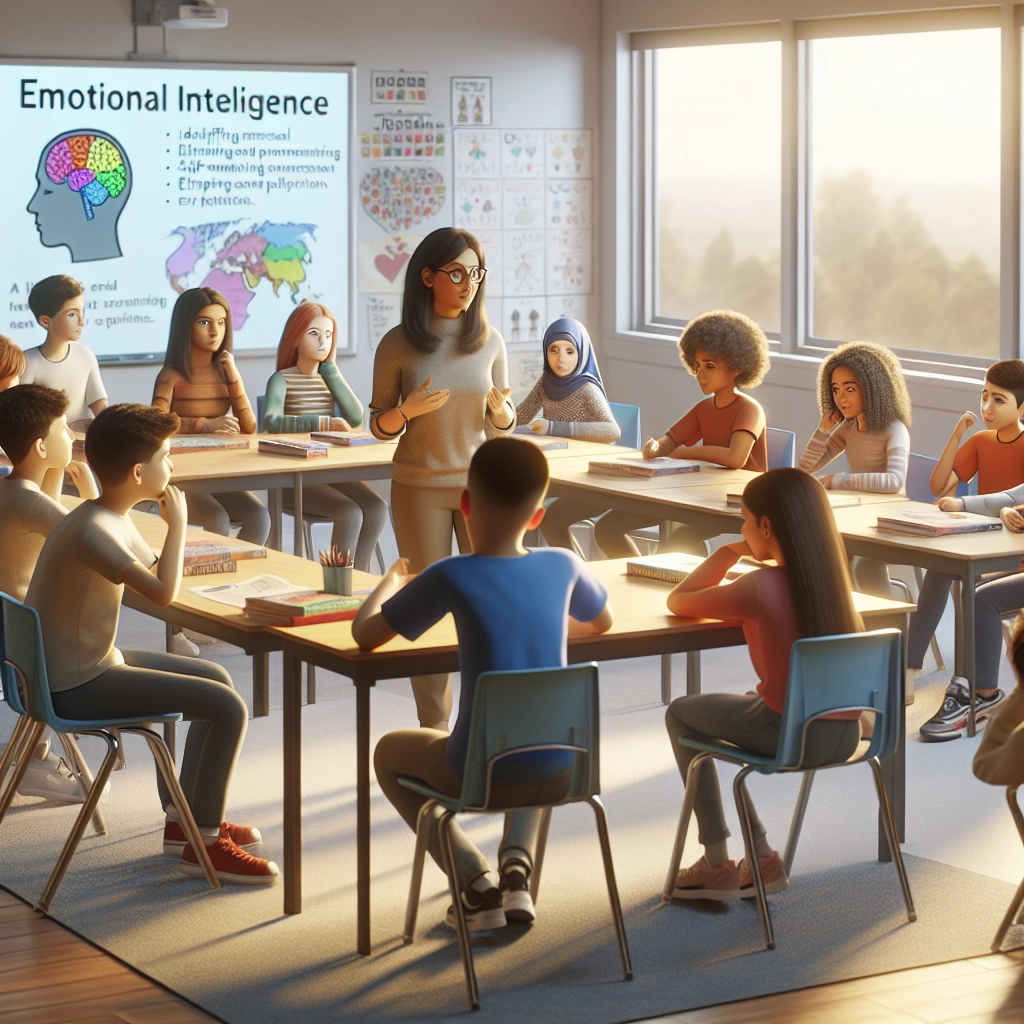Social-emotional Needs Of Students Examples: Practical Activities


Social-emotional needs of students refers to the need for safety, love, attention, understanding, and a sense of self-worth. Addressing these needs is crucial for the overall well-being and academic success of students.
Research has shown that meeting the social-emotional needs of students can lead to improved academic achievement and the development of important life skills.
Supporting the social-emotional needs of students provides a positive impact on their learning and long-term success. Recognizing and addressing these needs not only improves academic performance but also fosters the development of pro-social behaviors.
In addition, creating a safe and supportive environment for students to express their emotions and develop relationships is essential for their overall well-being. The importance of social-emotional learning in schools cannot be understated, as it equips students with the necessary skills to navigate challenges both inside and outside the classroom.
Schools have a significant role in meeting the social-emotional needs of students, as emotional and physical safety is strongly correlated with academic performance. By integrating social-emotional learning into academic curriculum and providing support for students’ mental and emotional well-being, schools can help students thrive academically and personally.
Adapting and innovating to provide for students’ social-emotional needs, especially in the midst of the current pandemic, is crucial for ensuring that students are equipped to handle challenges and succeed in all areas of their lives.
Check out this Youtube video: Discover practical examples and tips for meeting the social-emotional needs of students in the classroom and beyond!
Understanding the Social-Emotional Needs of Students
Definition of social-emotional needs
Social-emotional needs in students refer to the requirements for healthy emotional and social development, encompassing the ability to regulate emotions, establish healthy relationships, and adapt to social situations. These needs are crucial for fostering resilience, empathy, and positive self-image among students.
The impact of unmet social-emotional needs on student well-being
When students’ social-emotional needs are unmet, it can lead to various detrimental effects on their well-being. This may include heightened levels of stress, difficulty in managing emotions, challenges in forming meaningful connections with peers, and an increased risk of behavioral issues or mental health concerns.
Key factors that contribute to social-emotional development in students
Several key factors contribute to the social-emotional development in students. These encompass supportive and nurturing environments at home and school, opportunities for open communication and expression, building resilience through overcoming challenges, and promoting a sense of belonging and inclusivity within the school community.
| Factors contributing to social-emotional development |
|---|
| Supportive and nurturing environments |
| Opportunities for open communication and expression |
| Building resilience through overcoming challenges |
| Promoting a sense of belonging and inclusivity |
Identifying Different Social-Emotional Needs in Students
Examples of social-emotional needs in students
Students may need examples of situational empathy, conflict resolution, and self-awareness to develop their social-emotional skills. For instance, implementing peer mentorship programs can provide students examples of empathy and understanding, while conflict resolution workshops can offer practical examples on managing disagreements.
Similarly, promoting self-reflection and mindfulness activities can help students understand and address their own emotions.
Signs of unmet social-emotional needs
Signs of unmet social-emotional needs in students may include persistent feelings of isolation, difficulty managing emotions, recurring social conflicts, and a lack of empathy or understanding towards others. Students exhibiting withdrawal from social activities, chronic frustration, or challenges in forming and maintaining relationships may also indicate unmet social-emotional needs.
Additionally, academic struggles, resistance to authority, or frequent emotional outbursts can signal underlying social-emotional challenges.
Case studies highlighting the impact of unmet social-emotional needs on students
| Case Study | Impact of Unmet Needs |
|---|---|
| Student A | Unmanaged emotions led to a decline in academic performance, impacting overall well-being and disrupting classroom dynamics. |
| Student B | Persistent social conflicts resulted in alienation and disengagement, affecting the student’s sense of belonging and mental health. |
| Student C | Lack of empathy and self-regulation hindered teamwork and collaborative efforts, affecting the student’s ability to function effectively in group settings. |
By incorporating these practical examples and understanding the signs, educators and parents can effectively identify and address the social-emotional needs of students, fostering a supportive and enriching learning environment.
Addressing Social-Emotional Needs in the Classroom
Practical activities to promote social-emotional development in the classroom
- Implementing daily check-ins for students to share their feelings.
- Incorporating mindfulness exercises, such as deep breathing and guided meditations.
- Organizing class discussions on empathy, kindness, and conflict resolution.
- Encouraging collaborative group projects to foster teamwork and communication.
- Using journaling and reflection activities to enhance self-awareness and emotional expression.
Incorporating social-emotional learning into the curriculum
- Introducing literature that showcases diverse characters and addresses social issues.
- Infusing art activities into the curriculum to promote creativity and emotional expression.
- Integrating role-playing exercises to help students understand perspectives and emotions.
- Creating opportunities for students to explore real-world challenges and develop solutions.
- Using storytelling and narratives to teach lessons on empathy, compassion, and resilience.
The role of educators in supporting students’ social-emotional needs
| Role of Educators | Description |
|---|---|
| Promote a positive classroom environment | Fostering a nurturing and inclusive setting for students. |
| Setting clear expectations and boundaries | Establishing guidelines for behavior and emotional regulation. |
| Being a positive role model | Demonstrating empathy, kindness, and emotional intelligence. |
| Providing opportunities for meaningful interactions | Encouraging open communication and supportive relationships. |
| Offering guidance and support during challenging times | Assisting students in managing emotions and building resilience. |
Addressing the social-emotional needs of students involves practical activities, effective integration into the curriculum, and the pivotal role of educators in providing support. By implementing these strategies, educators can create an environment that nurtures students’ emotional development and equips them with vital social and emotional skills for life.
Building Positive Relationships and Support Systems
Cultivating a supportive school environment
Creating a supportive school environment involves inclusive policies that allow students to fully participate in the classroom and school community, avoiding unnecessary removals from the learning environment. Additionally, fostering a staff culture that promotes shared responsibility for the well-being of all students is crucial.
This can be achieved through inclusive practices and active collaboration.
Encouraging peer support and collaboration
Encouraging peer support and collaboration in the classroom can be achieved by introducing group or peer work early in the semester. Establishing clear expectations and ground rules for participation and contributions can promote positive relationships among students.
Furthermore, offering different methods of support, such as one-to-one or group sessions, enables students to engage with their peers effectively.
Involving parents and caregivers in addressing students’ social-emotional needs
Involving parents and caregivers in addressing students’ social-emotional needs is essential for creating a holistic support system. Educating families on the importance of building core social-emotional skills and providing them with strategies for supporting their children’s emotional well-being can strengthen the home-school partnership.
Additionally, initiating discussions and providing progress updates to families about their students’ social and emotional development can foster a collaborative approach to addressing students’ needs.
Self-Regulation and Emotional Management Strategies
Teaching students self-regulation techniques:
One effective technique for teaching self-regulation to students is through the use of mindfulness exercises. Mindfulness promotes awareness of thoughts and emotions, helping students to regulate their responses in stressful situations.
For example, guiding students through breathing exercises and awareness practices can empower them to manage their emotions and reactions effectively.
Coping mechanisms for emotional management:
An essential coping mechanism for emotional management is creating a structured routine. By establishing a daily routine, students can develop a sense of predictability and control, reducing anxiety and promoting emotional stability.
Additionally, teaching students to practice positive self-talk and cognitive reframing can help them reframe negative thoughts and emotions into more constructive perspectives, aiding in effective emotional management.
Providing a safe space for students to express their emotions:
Creating designated safe spaces in school environments allows students to freely express their emotions without fear of judgment. For instance, establishing a calming corner with soft furnishings and sensory tools can offer a safe retreat for students to relax and process their feelings.
Moreover, encouraging open conversations and empathetic listening within the classroom environment cultivates a culture of emotional support and understanding for students to express themselves.
| Teaching students self-regulation techniques | Coping mechanisms for emotional management | Providing a safe space for students to express their emotions |
|---|---|---|
| Mindfulness exercises | Structured routine | Designated safe spaces |
| Breathing exercises and awareness practice | Positive self-talk and cognitive reframing | Calming corner with sensory tools |
Promoting Empathy and Understanding
Empathy-building activities for students
Encourage students to participate in activities like the “emotions board” exercise, where they write down an emotion, a related thought and action, and something they might say when experiencing that emotion. This helps them understand and express their feelings while promoting compassionate listening and understanding.
Fostering a culture of understanding and acceptance
Create an inclusive classroom culture by expressing genuine interest in students’ ethnic backgrounds. By encouraging students to research and share information about their cultural heritage, a trusting and inclusive environment can be fostered, celebrating diversity and promoting understanding.
Creating opportunities for students to learn about diverse perspectives
Incorporate cultural awareness into the curriculum by analyzing and celebrating differences in traditions, beliefs, and social behaviors. By acknowledging and respecting the diverse perspectives of students, educators can promote empathy, strengthen the classroom community, and enhance individual students’ sense of identity.
Developing Emotional Intelligence
Developing emotional intelligence in students can be achieved through various practices. For instance, promoting self-awareness by encouraging students to identify and understand their emotions is crucial.
Additionally, teaching empathy and nurturing interpersonal skills are effective ways to enhance emotional intelligence. Moreover, incorporating mindfulness and self-regulation techniques into classroom activities can significantly contribute to students’ emotional growth.
These practices not only improve emotional intelligence but also promote positive mental health and overall well-being.
Practices to enhance emotional intelligence in students
Incorporating emotional awareness into lesson plans is imperative for nurturing emotional intelligence in students. This can be achieved by integrating activities that encourage self-reflection and emotional expression.
For example, including journaling exercises, group discussions on feelings, and storytelling sessions can help students recognize and process their emotions effectively. Furthermore, promoting a safe and supportive classroom environment where students feel comfortable expressing their emotions without fear of judgment is essential for fostering emotional awareness.
Encouraging open communication and expression of feelings
Encouraging open communication and expression of feelings is vital for developing emotional intelligence in students. Teachers can create opportunities for students to share their thoughts and emotions through class discussions, one-on-one interactions, and peer-to-peer activities.
Additionally, incorporating role-playing exercises and utilizing tools such as emotion wheels and mood scales can help students recognize and communicate their feelings more effectively. By fostering an environment where open communication is valued, students can develop essential emotional intelligence skills and build stronger interpersonal relationships.
| Practice | Example |
|---|---|
| Encourage self-awareness | Encourage students to identify and understand their emotions |
| Teach empathy and interpersonal skills | Include activities that nurture empathy and promote healthy relationships |
| Incorporate mindfulness and self-regulation techniques | Integrate activities that promote mindfulness and self-regulation into lesson plans |
Developing emotional intelligence in students requires a multi-faceted approach that focuses on self-awareness, empathy, and effective communication. By incorporating these practices into the classroom, educators can create a supportive and nurturing environment that fosters emotional growth and overall well-being.
Providing Mental Health Support and Resources
Access to mental health resources in the school setting
School districts can provide access to mental health resources by incorporating on-site therapists or social workers, implementing prevention programs, and offering early identification and treatment options for students facing mental health challenges. These resources can significantly improve access to care and reduce the stigma associated with seeking help for mental health issues.
Strategies for destigmatizing mental health discussions
One effective strategy for destigmatizing mental health discussions in schools is to encourage open conversations about mental health. Educating both students and staff about mental health, using appropriate and sensitive language, and promoting equality between physical and mental illnesses can contribute to reducing the stigma associated with mental health issues.
Collaboration with mental health professionals to support students’ needs
Schools can collaborate with mental health professionals by investing in counselors or psychologists who provide direct support to students. Establishing partnerships with third-sector organizations or charities to deliver a range of mental health support services can also be beneficial.
Effective collaboration with professionals can ensure that students receive comprehensive support for their mental health needs.
Integrating Social-Emotional Learning Across Subjects
Examples of interdisciplinary activities that promote social-emotional development
One example of an interdisciplinary activity that promotes social-emotional development is a collaborative science project where students work in teams to conduct experiments and present their findings. This not only enhances their scientific knowledge but also fosters skills like communication, teamwork, and problem-solving.
Making connections between academic subjects and social-emotional skills
By integrating literature into history lessons, students not only learn about historical events but also empathize with the characters’ experiences, developing skills of understanding and emotional intelligence. Similarly, incorporating real-world mathematical problems can teach students perseverance and resilience in problem-solving.
The impact of integrated social-emotional learning on overall student success
Integrated social-emotional learning has a profound impact on overall student success, leading to improved academic performance, reduced disciplinary issues, and increased social competence. Students develop a deeper understanding of themselves and others, leading to a more positive classroom environment and better long-term outcomes.
Implementing Restorative Practices
Restorative justice approaches in addressing social-emotional needs
In addressing the social-emotional needs of students, restorative justice approaches play a pivotal role. By embracing restorative practices, educators can create a supportive environment where students feel heard, valued, and understood.
For example, organizing restorative circles allows students to openly discuss their feelings, thereby fostering empathy and emotional intelligence. Moreover, implementing affective statements helps students express their emotions constructively, leading to a deeper understanding of their social-emotional needs.
Conflict resolution strategies for students
When it comes to conflict resolution, restorative practices offer effective strategies for students to resolve disputes amicably. For instance, promoting mindfulness in the classroom equips students with the tools to manage conflicts and interact positively with their peers.
Additionally, leveraging restorative circles proactively helps build connections among students, laying a foundation for resolving conflicts harmoniously. By integrating these strategies into the school environment, educators can empower students to navigate and address conflicts through peaceful and constructive means.
Creating a culture of accountability and growth through restorative practices
Implementing restorative practices fosters a culture of accountability and growth within the school community. By allowing students to participate in restorative conversations, they learn to take responsibility for their actions and understand the impact of their behavior.
This active involvement not only promotes self-accountability but also cultivates a sense of ownership in the students. Furthermore, utilizing restorative practices as a whole-school approach fosters community building and strengthens relationships, thereby creating an environment where students can thrive and grow emotionally, academically, and socially.
| Restorative Justice Approaches | Conflict Resolution Strategies | Accountability and Growth through Restorative Practices |
|---|---|---|
| Restorative circles facilitate open discussions and build empathy among students | Implementing mindfulness techniques for conflict management | Engaging students in restorative conversations fosters accountability and personal growth |
Leveraging Technology for Social-Emotional Learning
Technology plays a crucial role in promoting social-emotional development among students. Digital tools like Gimkit, Quizizz, Nearpod, and Pear Deck offer interactive platforms where students can engage in activities that enhance empathy, collaboration, and responsible decision-making skills.
For instance, students can weigh the pros and cons of different choices, practice empathy, and collaborate effectively through these tools, fostering their social-emotional growth.
Ethical use of technology in addressing students’ social-emotional needs is a paramount consideration. It’s imperative to ensure that technology integration is carried out ethically, with a keen focus on safeguarding students’ privacy, data security, and online behavior.
Educators must be mindful of the ethical challenges presented by technology and strive to create a safe and respectful online environment that supports students’ holistic development.
Balancing technology with in-person support and interaction is essential for cultivating well-rounded social-emotional skills. While technology enhances learning experiences, it’s crucial to strike a balance with in-person interactions and support.
Utilizing technology in conjunction with in-person activities such as team-based sports, collaborative projects, and enriching discussions fosters a comprehensive approach to social-emotional learning, ensuring students benefit from both digital and face-to-face experiences.
Partnering with Community Organizations and Resources
Collaborating with outside organizations to support students’ social-emotional needs
Collaborating with outside organizations to support students’ social-emotional needs is crucial for their overall well-being. For example, partnering with local mental health centers can provide students with access to counseling services and emotional support.
Additionally, connecting with community-based organizations that offer mentorship programs can help students develop positive social relationships and build resilience.
Leveraging community resources for students’ well-being
Leveraging community resources for students’ well-being involves tapping into local resources to enhance students’ emotional and social development. For instance, establishing partnerships with community centers to provide students with access to art, music, and recreational programs can contribute to their emotional expression and overall well-being.
Moreover, collaborating with local libraries to organize reading and storytelling sessions can foster a love for learning and create a sense of community.
Providing students with access to extracurricular activities and programs that promote social-emotional growth
Providing students with access to extracurricular activities and programs that promote social-emotional growth can greatly benefit their holistic development. For instance, offering drama and theater clubs can help students boost their confidence and communication skills.
Furthermore, organizing team sports activities, such as basketball or soccer leagues, can promote teamwork, empathy, and conflict resolution among students.
| Example | Collaboration |
|---|---|
| Connecting with a mindfulness organization to offer meditation sessions | Enhancing students’ emotional regulation and stress management |
Evaluation and Monitoring of Social-Emotional Growth
Assessing students’ social-emotional development
A crucial aspect of assessing students’ social-emotional development is through the use of self-assessment activities. For instance, employing entrance slips for self-awareness assessment and goal trackers for self-management evaluation can provide valuable insights into students’ social-emotional competencies.
Additionally, incorporating role plays for social awareness assessment and personal journals for reflections can further enhance the evaluation process.
Incorporating feedback and reflection into social-emotional learning activities
To incorporate feedback and reflection into social-emotional learning activities, it can be beneficial to provide students with personal journals where they can document their daily experiences, thoughts, and emotions. Furthermore, encouraging students to engage in role-playing social situations and allowing them to become pen-pals with peers from different schools can foster valuable opportunities for feedback, reflection, and enhanced social-emotional learning.
Tracking the impact of interventions on students’ well-being
An effective method for tracking the impact of interventions on students’ well-being involves utilizing student plan documents as part of the intervention monitoring process. These documents can outline implemented interventions, include student Return on Investment (ROI), and track growth percentiles from previous intervention meetings.
By consistently monitoring and updating these documents, educators can gain valuable insights into the effectiveness of interventions on students’ overall well-being.
| Advantages | Challenges |
|---|---|
| Provides valuable insights into students’ social-emotional competencies | Requires well-structured assessment methods |
| Fosters opportunities for student reflection and personal growth | May require significant time and effort to implement and analyze |
| Allows for the tracking of intervention effectiveness | Demand for continuous monitoring and documentation |
Providing Support for Diverse Student Populations
Adapting social-emotional support for students with different cultural backgrounds
Cultural responsiveness in education is crucial for adapting social-emotional support to diverse student populations. For example, incorporating culturally relevant literature and materials in the curriculum can help students feel more connected and understood.
Additionally, organizing cultural events and celebrations within the school can foster a sense of belonging and support the social-emotional needs of students from different cultural backgrounds.
Addressing the social-emotional needs of students with disabilities
Addressing the social-emotional needs of students with disabilities requires tailored approaches. For instance, providing access to specialized support services such as counseling and therapy can help address emotional challenges.
Furthermore, promoting inclusivity in extracurricular activities and ensuring physical accessibility within school premises are essential in meeting the social-emotional needs of students with disabilities.
Creating inclusive environments for all students to thrive
Creating inclusive environments involves implementing strategies such as peer support programs and mentorship initiatives to foster a sense of belonging for all students. For instance, organizing diversity workshops and training for both students and staff can promote understanding and empathy.
Moreover, establishing inclusive practices in classroom management and encouraging open dialogue can contribute to the creation of an environment where all students can thrive.
Professional Development for Educators
Training and resources for educators to support students’ social-emotional needs
Educators can support students’ social-emotional needs by incorporating evidence-based social and emotional learning (SEL) programs. For example, teaching specific routines for calming down and resolving disputes can foster emotional and social skills.
Additionally, advisories and guidance counseling can be utilized to develop social and ethical skills.
Building a culture of empathy and understanding among school staff
To build a culture of empathy and understanding among school staff, educators should focus on creating a positive classroom culture. They can achieve this by making the classroom a place where students feel comfortable, confident, and supported in their learning.
Additionally, teachers should increase their visibility within the school to foster spontaneous relationships and offer support when needed.
The impact of educator well-being on students’ social-emotional development
The well-being of educators has a significant impact on students’ social-emotional development. When educators prioritize their own well-being, they can model healthy social and emotional behaviors for their students.
Moreover, when educators are emotionally and mentally balanced, they can create a supportive and nurturing environment that positively influences students’ social and emotional growth.
| Social-Emotional Support Methods | Impact |
|---|---|
| Evidence-based SEL programs | Fosters emotional and social skills |
| Advisories and guidance counseling | Develops social and ethical skills |
| Positive classroom culture | Creates a comfortable and supportive learning environment |
| Increased educator visibility | Spontaneously fosters relationships and support |
| Educator well-being | Positively influences students’ social and emotional growth |
Educators play a crucial role in supporting students’ social-emotional needs by implementing evidence-based SEL programs, creating a positive classroom culture, and prioritizing their own well-being. By doing so, they contribute to the holistic development of students and create an environment conducive to emotional and social growth.
Recommended Amazon Products for Addressing Social-Emotional Needs in Students
Here’s a curated list of products that can help in addressing the social-emotional needs of students with ease. These recommendations are based on functionality, price, and reviews.
Calm Focus Fidget Toys
Calm Focus Fidget Toys are designed to help students relieve stress and anxiety, improve focus, and regulate emotions. These toys come in various shapes and textures, providing sensory stimulation and promoting a sense of calm. Calm Focus Fidget Toys


The Mood Meter: Emotions Chart
The Mood Meter is a visual tool that helps students identify and categorize their emotions, promoting emotional awareness and regulation. It facilitates discussions about feelings and creates a safe space for students to express themselves. The Mood Meter


Mindful Games Activity Cards
Mindful Games Activity Cards provide a variety of activities and exercises to promote mindfulness, empathy, and emotional intelligence in students. These cards offer practical strategies for educators to incorporate social-emotional learning into the curriculum. Mindful Games Activity Cards


Squeezy Inflatable Sensory Chair
The Squeezy Inflatable Sensory Chair provides a flexible seating option for students to enhance focus, concentration, and comfort. It is designed to encourage movement and relaxation, supporting students’ sensory needs in the classroom. Squeezy Inflatable Sensory Chair


Top Recommended Product for Addressing Social-Emotional Needs in Students
If you’re looking for the best solution for addressing the social-emotional needs of students, we highly recommend Mindful Games Activity Cards. Here’s why:
- Pros:
| Pros | Details |
|---|---|
| Promotes mindfulness | Utilizes various games and activities to promote mindfulness in students |
| Encourages empathy | Fosters empathy and understanding through interactive exercises |
| Practical and versatile | Suitable for various age groups and can be easily incorporated into lesson plans |
- Cons:
| Cons | Details |
|---|---|
| Limited to classroom use | May not be applicable for students who are learning remotely or at home |
| Requires facilitation | Educators need to provide guidance and support during the activities |
| Initial cost | Initial investment required to purchase the activity cards |
Conclusion
Addressing the social-emotional needs of students is crucial for their overall well-being and academic success. By recognizing and supporting these needs, educators can create a positive and inclusive learning environment where students feel valued and understood.
It is essential for educational institutions to prioritize the social-emotional development of students as part of their academic curriculum. This includes integrating social-emotional learning into the school’s culture and providing resources for teachers to implement effective strategies in the classroom.
In supporting students’ social-emotional needs, educators can engage in practical activities such as mindfulness exercises, group discussions, and promoting empathy and kindness. By incorporating these strategies into the educational setting, students can develop essential skills for managing emotions, building relationships, and thriving both in and out of school.


















